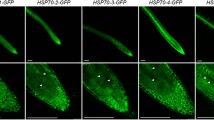Abstract
Six heat shock transcription factors (HSFs) have been isolated and characterized from soybean and two from Arabidopsis (Czarnecka-Verner et al. 1995; Barros, Czarnecka-Verner and Gurley, unpublished). Based on a phylogeny analysis of the DNA binding domains and organization of oligomerization domains, they have been assigned to classes A2 and B of the plant HSF family (Nover et al. 1996). In vivo studies of full length HSFs were conducted in transient expression systems using a GUS reporter driven by a heat shock element (HSE) located upstream from the minimal 35S CaMV promoter. Neither soybean nor Arabidopsis HSF class B members were able to function as transcriptional activators under control or heat stress conditions. Conversely, class A HSFs from tomato and Arabidopsis have the capacity to activate transcription. Co-expression studies of activator HSFs from tomato and Arabidopsis, and inert HSFs from soybean and Arabidopsis demonstrated that the inert HSFs were able to trans-attenuate the transcriptional activity of activator HSFs. We suggest that heat shock regulation in plants may differ from metazoan systems by partitioning negative and positive functional domains onto separate HSF proteins. In plants two classes of HSFs exist: class A members, i.e. HSF activators, and a novel class B (inert HSFs) which is largely specialized for repression, or attenuation, of the heat shock response.
Similar content being viewed by others
References
Cotto J.J., Kline M., Morimoto R.I. 1996. Activation of heat shock factor 1 DNA binding precedes stress-induced serine phosphorylation. Evidence for a multistep pathway of regulation. J. Biol. Chem. 271: 3355–8.
Czarnecka-Verner E., Yuan C.-X., Fox P.C., Gurley W.B. 1995. Isolation and characterization of six heat shock transcription factor cDNA clones from soybean. Plant Mol. Biol. 29: 37–51.
Gagliardi D., Breton C., Chaboud A., Vergne P., Dumas C. 1995. Expression of heat shock factor and heat shock protein 70 genes during maize pollen development. Plant Mol. Biol. 29: 841–856.
Green M. S., T. J., Sullivan E. K., Kingston R. E. 1995. A heat shock-responsive domain of human HSF1 that regulates transcription activation domain function. Mol. Cell. Biol. 15(6):3354–3362.
Hubel A., Lee J.H., Wu C., Schöffl F. 1995. Arabidopsis heat shock factor is constitutively active in Drosophila and human cells. Mol. Gen. Genet. 248:136–141.
Hubel A., Schöffl F. 1994. Arabidopsis heat shock factor: isolation and characterization of the gene and the recombinant protein. Plant Mol. Biol. 26: 353–363.
Hull G.A., Devic M. 1995. The b-glucuronidase (GUS) reporter gene system. In Plant gene transfer and expression protocols., edited by H. Jones. University of Hertfordshire, Hatfield, UK: Humana Press, Tatowa, New Jersey.
Jurivich D.A., Sistonen L., Kroes R.A., Morimoto R.I. 1992. Effect of sodium salicylate on the human heat shock response. Science 255:1243–1245.
Kline M.P., Morimoto R.I. 1997. Repression of the heat shock factor 1 transcriptional activation domain is modulated by constitutive phosphorylation. Mol. Cell. Biol. 17: 2107–2115.
Lee J.H., Schöffl F. 1996. An Hsp70 antisense gene affects the expression of HSP70/HSC70, the regulation of HSF, and the acquisition of thermotolerance in transgenic Arabidopsis thaliana. Mol. Gen. Genet. 252: 11–19.
Nakai A., Tanabe M., Kawazoe Y., Inazawa J., Morimoto R.I., Nagata K. 1997. HSF4, a new member of the human heat shock factor family which lacks properties of a transcriptional activator. Mol. Cell. Biol. 17: 469–481.
Newton E.M., Knauf U., Green M., Kingston R.E. 1996. The regulatory domain of human heat shock factor 1 is sufficient to sense heat stress. Mol. Cell. Biol. 16(3): 839–846.
Nover L., Scharf K.-D., Gagliardi D., Vergne P., Czarnecka-Verner E., Gurley W.B. 1996. The Hsf world: classification and properties of plant heat stress transcription factors. Cell Stress & Chaperones 1: 215–223.
Rabindran S.K., Haroun R.I., Clos J., Wisniewski J., Wu C. 1993. Regulation of heat shock factor trimer formation: role of a conserved leucine zipper. Science 259: 230–234.
Scharf K.-D., Rose S., Zott W., Schöffl F., Nover L. 1990. Three tomato genes code for heat stress transcription factors with a region of remarkable homology to the DNA-binding domain of the yeast HSF. EMBO J. 9: 4495–4501.
Shi Y., Kroeger P.E., Morimoto R.I. 1995. The carboxyl-terminal transactivation domain of heat shock factor is negatively regulated and stress responsive. Mol. Cell. Biol. 15: 4309–4318.
Shimizu S., Itoh Y., Yamazaki K. 1996. Temperature-dependent increase in the DNA-binding activity of a heat shock factor in an extract of tobacco culture cells. Plant Mol. Biol. 31:13–22.
Treuter E., Nover L., Ohme K., Scharf K.-D. 1993. Promoter specificity and deletion analysis of three heat stress transcription factors of tomato. Mol. Gen. Genet. 240: 113–125.
Winegarden N.A., Wong K.S., Sopta M., Westwood J.T. 1996. Sodium salicylate decreases intracellular ATP, induces both heat shock factor binding and chromosomal puffing, but does not induce hsp 70 gene transcription in Drosophila. J. Biol. Chem. 271: 26971–80.
Wisniewski J., Orosz A., Allada R., Wu C. 1996. The C-terminal region of Drosophila heat shock factor (HSF) contains a constitutively functional transactivation domain. Nucleic Acids Res. 24: 367–374.
Wu C. 1995. Heat shock transcription factors: structure and regulation. Annu. Rev. Cell Dev. Biol. 11: 441–69.
Zuo J., Rungger D., Voellmy R. 1995. Multiple layers of regulation of human heat shock transcription factor 1. Mol. Cell. Biol. 15: 4319–4330.
Author information
Authors and Affiliations
Rights and permissions
About this article
Cite this article
Czarnecka-Verner, E., Yuan, CX., Nover, L. et al. Plant heat shock transcription factors: positive and negative aspects of regulation. Acta Physiol Plant 19, 529–537 (1997). https://doi.org/10.1007/s11738-997-0050-5
Issue Date:
DOI: https://doi.org/10.1007/s11738-997-0050-5




